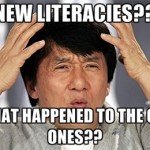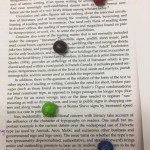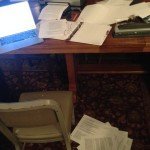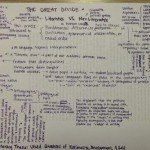
Catherine Wilcox: New Literacy Studies in Practice
New Literacy Studies in Practice
Street’s argument is positioned in direct conversation with Brandt & Clinton’s (2002) “Limits of the Local,” in that it illuminates the divide between local and global literacies. Street (2003) acknowledges that Brandt and Clinton (2002) create a “helpful way of characterizing the local / global debate in which literacy practices play a central role” (80). He notes that their qualms about the difficulty of making generalizations based on small analyses of local literacies is a valid concern. However, he argues that Brandt & Clinton’s (2002) attempt to label “distant” literacies as “autonomous” adds too much neutrality to the theory. Street’s piece is essentially an attempt to continue to see literacy, both locally and globally, as being embedded in social practices. He resists Brandt & Clinton’s attempts to neutralize the literacy practices that occur outside of local contexts.
One of Street’s more convincing and relatable examples of the socially embedded natures of both global and local literacies is actually a small example that he mentions, almost in passing. Street briefly explains Kulick & Stroud’s (1993) research of a New Guinea tribe that adapted literacy received from missionaries to fit their local circumstances. He points out that such an example shows how a mesh of local and global literacies usually results in a hybrid practice rather than a pure form of either version. There is no clear delineation between what is local and what is global in such a circumstance.
This is a concept that we can see play out in our own experiences. When new technologies enter schools, for example, they get repurposed to fit the literacy needs of that social group. Academic literacy practices such as the Twitter essay (Stommel, 2012) or writing with blogs are examples of global literacies (social media) being repurposed and hybridized to fit the literacy needs of a local group (a classroom). This makes me question whether social media (or any literacy platform) can truly ever be classified as “global?” After all, isn’t New Literacy Studies all about arguing that literacy is always localized and embedded in social practices because individuals who infuse their literacy practices with the social values of their local context?
If one is to argue that literacy can be “global,” one must also argue that there are practices that transcend local contexts and can be generalized. This is what Brandt and Clinton (2002) attempt to do when they say that global literacies are “any things associated with unified communication systems” (p. 352). However, at best, it seems to me that so-called “global” literacy is actually hybrid of local literacies. Let’s use the example of the missionaries who brought literacy to New Guinea. In this example, the literacy of the missionaries is the “global” literacy while the practices of the New Guineans localize the literacy to fit their needs. However, Bartlett & Holland (2002) would argue that, the missionaries’ literacy was sponsored and shaped by historical and social forces that influenced their “linguistic habitus” and practices (p.6 as cited in Street, 2003, p. 81). Therefore, although the literacy of the missionaries was certainly “distant” to the practices of the New Guineans, wouldn’t it be quite a leap (and quite colonial) to say that the literacy of the missionaries was “global,” not only because the word “global” has amorphous, universalist connotations, but because the literacy practices of the missionaries were also embedded in their own unique, local context. Similar to Street, I would argue that a hybrid literacy did form, but that it was the result of a local literacy melding with another local literacy rather than global literacy transforming a local literacy.
Before I digress too much further, let’s return to another interesting point in Street’s argument. After establishing his position in relation to that of Brandt & Clinton (2002) and several other scholars, he moves on to “develop positive proposals for interventions in teaching, curriculum, measurement criteria, and teacher education” (p. 82). To Street, this sort of practical application is the true test of the viability of New Literacy Studies as a theory that can accomplish real work in the world. One point of conflict that Street addresses is the divide between the diversity of local needs and the broader demands of policy makers and funding agencies. He points out that rigorous, scientific research is one way to bridge this gap, which brings me to a discussion of the fascinating research presented by Dr. Erin Whitney in class.
Whitney’s research is a beautiful example of certain generalizations that can be made about how junior high students express their literacies. Her research showed that, even though some students are diagnosed with learning disabilities because of low reading and writing test scores, these students can be very capable when using literacy in different genres and purposes than those that are tested in school. A student who struggled with the essay format was adept at expressing her knowledge by writing and performing plays and poems. Just as the New Guineans were able to adapt literacy to fit their community’s needs, the students that Dr. Whitney studied were able to adapt the literacies of their classrooms to fit the needs of their social groups and contexts. As Streets (2003) notes, unfortunately, the relationship between academic and lived literacies are quite strained, which could be a contributing factor to students’ difficulty with academic routes to success (p. 83).
So how does Dr. Whitney’s research fit in with New Literacy Studies? Her data and interpretations show that multimodal projects, collaboration, and digital pedagogies give students, particularly those with disabilities, the chance to demonstrate their knowledge using a wide array of available literacy practices that carry weight in their worlds outside of school.In the experiences of her students, literacy is not an autonomous set of skills that is neutrally given and received; literacy is instead an ideology that is embedded in local cultural and social practices of their community. Therefore, literacy pedagogy must be kept as open and fluid and possible in order to allow for the wide variety of interpretations and demands that are placed upon it by different contexts and communities.




